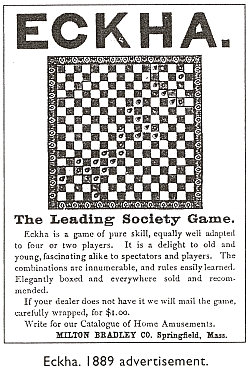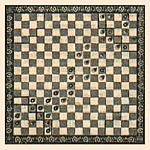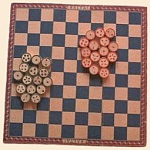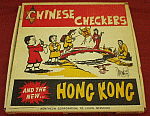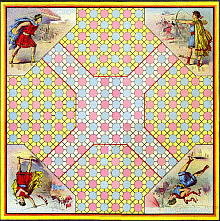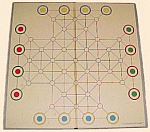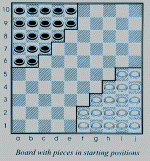|
Variations
According to Bruce Whitehill a game must meet the following two criteria to be considered as a variation: 1) a player's piece are required to finish in the starting space of the opposing player; and 2) piece movement includes the allowance for jumping all pieces, including a players own as well as an opponent's, without any pieces being removed from play
|
A
slightly modified version of Halma made by Milton Bradley in 1888-1889,
after they lost the battle for the name of Halma. Image from AbstractStrategy.com |
Eckha 1888 - Bruce Whitehill
|
|
Invented in 1899 by Konrad Büttgenbach from Düsseldorf. A two player game played on a square board of 10x10 spaces with fifteen pieces each. Same movements as in Halma. All pieces are given their own identity and must finish in the same positions in the opponents home base. Salta is Latin for 'Jump'. Very popular before World War One. There is also a variant called Pyramid (see Parlett, 1999, pg.135) More info: |
| Hong Kong
A Chinese Checkers variant using four different types of pieces; a scoring system gives different scores depending on whether the player can get certain pieces into specific finishing spots. Made by Kentheon Corporation (Heritage Games?) (St. Louis, Missouri) in 1950 or 1956. |
Telka / Peg Chow 4 player game with twelve pieces each. Best played in partnership. In front of the home area of each player and in the middle of the board there is a "Danger Territory". In this section opponents pieces are removed when jumping. The game is won when three of a player's pieces reach the opponents finish area. PDF - Rule set for Telka (and Peg Chow) from 1938 (Hasbro). Made by Parker Brothers in 1938 (or 1891?). Image from 'Rick Anderson Board Game Collection'. |
Troke Each player has four pieces called "castles". A castle is divided into three sections: the moat, the wall, and the tower. They move independently of the others unless captured. A capture can only be made by a different type of piece. When captured, the capturing piece move the entire unit one space for each piece captured. The game was originally spelled 'Troque', and is also known as Castle Checkers. Produced by Selchow & Richter in 1956. |
|
David Parlett (1999) mentions these three variations of Halma:
Colour Halma: The colour of the square determines the rules of movement. If a piece start on a dark square it must remain on dark squares only, moving one step diagonally and is not allowed to jump. A piece who start on a light square must remain on light squares only, and can only move by orthogonal jumps.
Marked Halma: Each player marks his corner piece and must get that piece to the opposite corner exactly
Grasshopper : A chessboard variant where the players start from the ten squares of diagonally opposite corners, or fifteen on the 10x10 draughtboard
|
The game of Super Halma (or 10x10 Super Halma) are described and discussed in an article by NB: First described in 1963 as "Halma mit Weitsprung" |
Perkis suggest this a standard Super Halma game: The game is played with 19 pieces per player on a 10x10 International Checkers board. The main feature is the altered rule for Jump move: A piece may jump over any other piece any number of empty spaces away, either orthogonally or diagonally, provided it can land the same number of empty spaces beyond it in a straight line. It is also possibly to trap a opponents piece.
Or said with other words: ...Where a stone jumps at any distance, provided that the jumped stone lies at the exact midpoint of the jump.
Super Chinese Checkers
Guess what is it :-). The Chinese Checkers entry in Wikipedia explains the rules (calls it the 'fast-paced variant'). First named by Wayne Schmittberger.
![]()
João Neto mentions some Halma variants on his homepage:
Top Secret: Another curious variant of Halma, is Top Secret, where each player drops in turns their 18 stones on the central 6x6 square area of the 16x16 board. Then, after all drops were made, the goal is to be the first to remove all stones moving or jumping over the board.
 Le Grec: A
simple variation is Le Grec
(by Dominique Huguenin and Yves Chédel) played in the next
diagram. The rules: (1) Move one friendly stone (orthogonal or
diagonal) to an empty cell, or jump over an enemy stone (no jumps over
friendly stones) landing on the immediate next cell. Every move/jump
must be forwards or sideways never backwards. (2) Wins the player that
moves his stones to the last two rows. [Play
as Java applet].
Le Grec: A
simple variation is Le Grec
(by Dominique Huguenin and Yves Chédel) played in the next
diagram. The rules: (1) Move one friendly stone (orthogonal or
diagonal) to an empty cell, or jump over an enemy stone (no jumps over
friendly stones) landing on the immediate next cell. Every move/jump
must be forwards or sideways never backwards. (2) Wins the player that
moves his stones to the last two rows. [Play
as Java applet].
Renpaarden:
There is also Renpaarden played on a 9x9 square board: Both players
start with the first two rows filled with friendly stones (so, 18
stones each). Stones move like chess knights: either to an empty
square, which ends the turn, or to a square with a piece of the
opponent; in the latter case, the piece can make another jump. (there
is no capturing.). Winner is who has all his stones at the two rows at
the opposite of the board.
More info in Dutch here.
 Le Zug
is played on the following 17x17 board. Below is a initial setup (the
stones on the second row can be placed at any column where they are
diagonally adjacent to the first row stones). Stones move diagonally
forward and can jump diagonally over stones of either color (jumps can
be multiple and are not mandatory). A piece which performs a jumping
move, whether single or multiple, is allowed to make an additional
diagonal step. All steps and jumps are forward only. The first four
rows of each side is considered the camp of that player. No piece may
be moved into an enemy camp while their are still friendly pieces in
their own. Wins the player that first occupies the last row, and place
the remaining three stones at the penultimate row. According to L. Lynn
Smith the title appears to be an
amalgamate of French and German. Its
meaning "The Course".
Le Zug
is played on the following 17x17 board. Below is a initial setup (the
stones on the second row can be placed at any column where they are
diagonally adjacent to the first row stones). Stones move diagonally
forward and can jump diagonally over stones of either color (jumps can
be multiple and are not mandatory). A piece which performs a jumping
move, whether single or multiple, is allowed to make an additional
diagonal step. All steps and jumps are forward only. The first four
rows of each side is considered the camp of that player. No piece may
be moved into an enemy camp while their are still friendly pieces in
their own. Wins the player that first occupies the last row, and place
the remaining three stones at the penultimate row. According to L. Lynn
Smith the title appears to be an
amalgamate of French and German. Its
meaning "The Course".
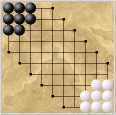
Carrera de Caballos, from Héctor Canteros, is played on the next board, where pieces move like non-capture chess Knights, i.e., they jump to one of the nearest cells not in the same column or row.
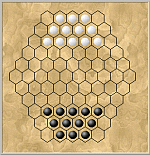 Hexma:
Check also Hexma (by
Cameron Browne)
a variant of Chinese Checkers with a connection touch: "a player wins
by completing a chain of their pieces between their home and away board
edges" (it should be use one of the mechanisms explained above to
remove drawish strategies). The same game on a typical hex board:
Hexma:
Check also Hexma (by
Cameron Browne)
a variant of Chinese Checkers with a connection touch: "a player wins
by completing a chain of their pieces between their home and away board
edges" (it should be use one of the mechanisms explained above to
remove drawish strategies). The same game on a typical hex board:
Combinations of Chess
and Halma:
The Chess
Variant Applets page mentions two Chess-Halma
combinations:
Chelma: a
C/H combination
with no royal unit. Java
applet
Emperor of China:
a C/H combination
with royal king. Java
applet. Also available as a game in the Zillions of Games
computer game.
The idea to create a crossover between Halma and Chess is not new. 'Schachhalma' ('Schach' is German for Chess) was described by Hajo Bücken and Dirk Hanneforth in their book 'Klassische Spiele ganz neu' which was first published in 1990.
![]()
Ugolki (russian for 'Corners')
 The most popular variant is supposed to be played with 3x3 start standing. Qoute from Wikipedia as of August 6, 2011:
The most popular variant is supposed to be played with 3x3 start standing. Qoute from Wikipedia as of August 6, 2011:Ugolki is a two-player board game that is typically played on an 8×8 grid board with 16 game pieces per player. It is said to have been invented in Europe in the late 18th century. Variations on the size of the board and the number of game pieces also exist.
Game Rules
Both players start off with square arrangements of 16 pieces in opposing corners of the game board. Each player's goal is to move all of the game pieces from the starting corner to the corner occupied by the opponent at the start of the game.
Players take turn moving one game piece. A game piece may move only away from the starting location into a destination that is empty, provided the following conditions are met:
- the destination square is adjacent to the starting square
- the destination square can be reached by consecutive "jumps" over other game pieces that belong to either player.
Main sources: Whitehill (2002) and Parlett (1999) - se sources in History section. Other sources listed.
![]()
|
© 2004 - 2011 Vegard Krog Petersen |
Home
History
Rules
Variations
Online
Freeware
Trialware
About
Links
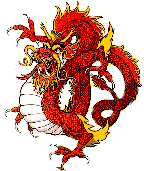
 Chinese Checkers
Chinese Checkers